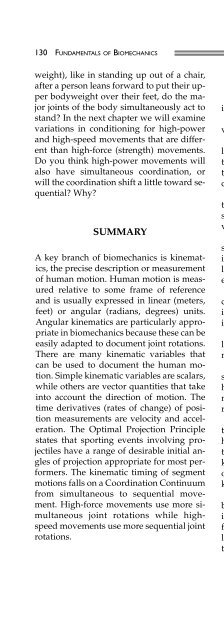Fundamentals of Biomechanics
Fundamentals of Biomechanics
Fundamentals of Biomechanics
You also want an ePaper? Increase the reach of your titles
YUMPU automatically turns print PDFs into web optimized ePapers that Google loves.
130 FUNDAMENTALS OF BIOMECHANICS<br />
weight), like in standing up out <strong>of</strong> a chair,<br />
after a person leans forward to put their upper<br />
bodyweight over their feet, do the major<br />
joints <strong>of</strong> the body simultaneously act to<br />
stand? In the next chapter we will examine<br />
variations in conditioning for high-power<br />
and high-speed movements that are different<br />
than high-force (strength) movements.<br />
Do you think high-power movements will<br />
also have simultaneous coordination, or<br />
will the coordination shift a little toward sequential?<br />
Why?<br />
SUMMARY<br />
A key branch <strong>of</strong> biomechanics is kinematics,<br />
the precise description or measurement<br />
<strong>of</strong> human motion. Human motion is measured<br />
relative to some frame <strong>of</strong> reference<br />
and is usually expressed in linear (meters,<br />
feet) or angular (radians, degrees) units.<br />
Angular kinematics are particularly appropriate<br />
in biomechanics because these can be<br />
easily adapted to document joint rotations.<br />
There are many kinematic variables that<br />
can be used to document the human motion.<br />
Simple kinematic variables are scalars,<br />
while others are vector quantities that take<br />
into account the direction <strong>of</strong> motion. The<br />
time derivatives (rates <strong>of</strong> change) <strong>of</strong> position<br />
measurements are velocity and acceleration.<br />
The Optimal Projection Principle<br />
states that sporting events involving projectiles<br />
have a range <strong>of</strong> desirable initial angles<br />
<strong>of</strong> projection appropriate for most performers.<br />
The kinematic timing <strong>of</strong> segment<br />
motions falls on a Coordination Continuum<br />
from simultaneous to sequential movement.<br />
High-force movements use more simultaneous<br />
joint rotations while highspeed<br />
movements use more sequential joint<br />
rotations.<br />
REVIEW QUESTIONS<br />
1. What is a frame <strong>of</strong> reference and why<br />
is it important in kinematic measurements?<br />
2. Compare and contrast the scalar and<br />
vector linear kinematic variables.<br />
3. Explain the difference between calculation<br />
<strong>of</strong> average and instantaneous velocities,<br />
and how does the length <strong>of</strong> the time interval<br />
used affect the accuracy <strong>of</strong> a velocity<br />
calculation?<br />
4. Use the velocity graph in Figure 5.4<br />
to calculate the average acceleration <strong>of</strong> the<br />
sprinter in the first and the last 10-m intervals.<br />
5. A patient lifts a dumbbell 1.2 m in 1.5<br />
s and lowers it back to the original position<br />
in 2.0 s. Calculate the average vertical velocity<br />
<strong>of</strong> the concentric and eccentric phases<br />
<strong>of</strong> the lift.<br />
6. Explain why linear and angular accelerations<br />
should be thought <strong>of</strong> as pushes<br />
in a particular direction rather than speeding<br />
up or slowing down.<br />
7. Why are angular kinematics particularly<br />
well suited for the analysis <strong>of</strong> human<br />
movement?<br />
8. From the anatomical position a person<br />
abducts their shoulder to 30º above the<br />
horizontal. What is the angular displacement<br />
<strong>of</strong> this movement with the usual directional<br />
(sign) convention?<br />
9. A soccer player attempting to steal<br />
the ball from an opponent was extending<br />
her knee at 50 deg/s when her foot struck<br />
the opponent's shin pads. If the player's<br />
knee was stopped (0 deg/s) within 0.2 seconds,<br />
what angular acceleration did the<br />
knee experience?<br />
10. A golfer drops a ball to replace a lost<br />
ball. If the ball had an initial vertical velocity<br />
<strong>of</strong> 0 m/s and had a vertical velocity before<br />
impact <strong>of</strong> –15.7 m/s exactly 1.6 seconds<br />
later, what was the vertical acceleration <strong>of</strong><br />
the ball?






